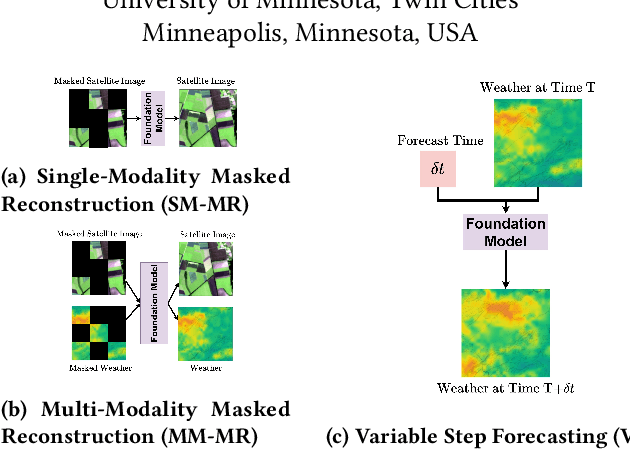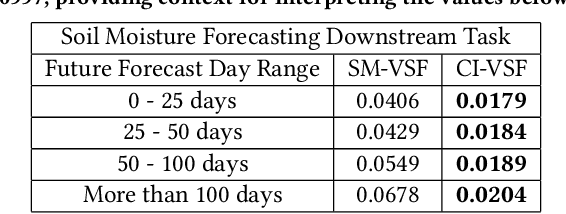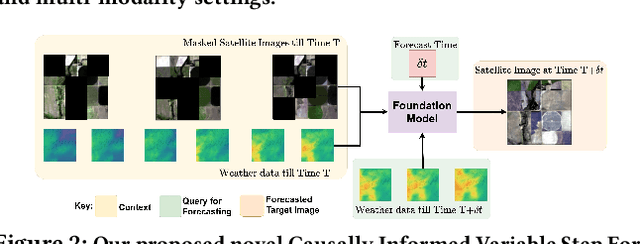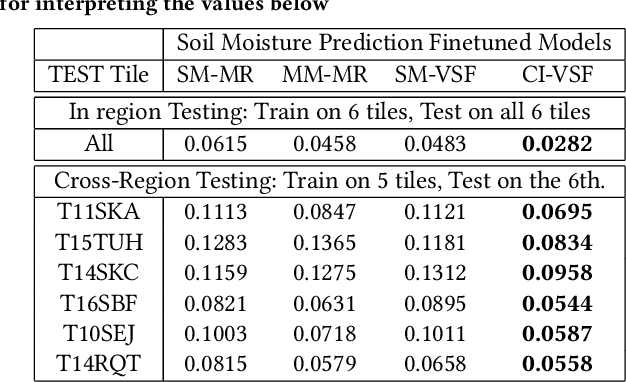Vipin Kumar
Hierarchical Conditional Multi-Task Learning for Streamflow Modeling
Oct 18, 2024Abstract:Streamflow, vital for water resource management, is governed by complex hydrological systems involving intermediate processes driven by meteorological forces. While deep learning models have achieved state-of-the-art results of streamflow prediction, their end-to-end single-task learning approach often fails to capture the causal relationships within these systems. To address this, we propose Hierarchical Conditional Multi-Task Learning (HCMTL), a hierarchical approach that jointly models soil water and snowpack processes based on their causal connections to streamflow. HCMTL utilizes task embeddings to connect network modules, enhancing flexibility and expressiveness while capturing unobserved processes beyond soil water and snowpack. It also incorporates the Conditional Mini-Batch strategy to improve long time series modeling. We compare HCMTL with five baselines on a global dataset. HCMTL's superior performance across hundreds of drainage basins over extended periods shows that integrating domain-specific causal knowledge into deep learning enhances both prediction accuracy and interpretability. This is essential for advancing our understanding of complex hydrological systems and supporting efficient water resource management to mitigate natural disasters like droughts and floods.
ExoTST: Exogenous-Aware Temporal Sequence Transformer for Time Series Prediction
Oct 16, 2024



Abstract:Accurate long-term predictions are the foundations for many machine learning applications and decision-making processes. Traditional time series approaches for prediction often focus on either autoregressive modeling, which relies solely on past observations of the target ``endogenous variables'', or forward modeling, which considers only current covariate drivers ``exogenous variables''. However, effectively integrating past endogenous and past exogenous with current exogenous variables remains a significant challenge. In this paper, we propose ExoTST, a novel transformer-based framework that effectively incorporates current exogenous variables alongside past context for improved time series prediction. To integrate exogenous information efficiently, ExoTST leverages the strengths of attention mechanisms and introduces a novel cross-temporal modality fusion module. This module enables the model to jointly learn from both past and current exogenous series, treating them as distinct modalities. By considering these series separately, ExoTST provides robustness and flexibility in handling data uncertainties that arise from the inherent distribution shift between historical and current exogenous variables. Extensive experiments on real-world carbon flux datasets and time series benchmarks demonstrate ExoTST's superior performance compared to state-of-the-art baselines, with improvements of up to 10\% in prediction accuracy. Moreover, ExoTST exhibits strong robustness against missing values and noise in exogenous drivers, maintaining consistent performance in real-world situations where these imperfections are common.
Towards a Knowledge guided Multimodal Foundation Model for Spatio-Temporal Remote Sensing Applications
Jul 29, 2024



Abstract:In recent years, there is increased interest in foundation models for geoscience due to vast amount of earth observing satellite imagery. Existing remote sensing foundation models make use of the various sources of spectral imagery to create large models pretrained on masked reconstruction task. The embeddings from these foundation models are then used for various downstream remote sensing applications. In this paper we propose a foundational modeling framework for remote sensing geoscience applications, that goes beyond these traditional single modality masked autoencoder family of foundation models. This framework leverages the knowledge guided principles that the spectral imagery captures the impact of the physical drivers on the environmental system, and that the relationship between them is governed by the characteristics of the system. Specifically, our method, called MultiModal Variable Step Forecasting (MM-VSF), uses mutlimodal data (spectral imagery and weather) as its input and a variable step forecasting task as its pretraining objective. In our evaluation we show forecasting of satellite imagery using weather can be used as an effective pretraining task for foundation models. We further show the effectiveness of the embeddings from MM-VSF on the downstream task of pixel wise crop mapping, when compared with a model trained in the traditional setting of single modality input and masked reconstruction based pretraining.
Hierarchically Disentangled Recurrent Network for Factorizing System Dynamics of Multi-scale Systems
Jul 29, 2024Abstract:We present a knowledge-guided machine learning (KGML) framework for modeling multi-scale processes, and study its performance in the context of streamflow forecasting in hydrology. Specifically, we propose a novel hierarchical recurrent neural architecture that factorizes the system dynamics at multiple temporal scales and captures their interactions. This framework consists of an inverse and a forward model. The inverse model is used to empirically resolve the system's temporal modes from data (physical model simulations, observed data, or a combination of them from the past), and these states are then used in the forward model to predict streamflow. In a hydrological system, these modes can represent different processes, evolving at different temporal scales (e.g., slow: groundwater recharge and baseflow vs. fast: surface runoff due to extreme rainfall). A key advantage of our framework is that once trained, it can incorporate new observations into the model's context (internal state) without expensive optimization approaches (e.g., EnKF) that are traditionally used in physical sciences for data assimilation. Experiments with several river catchments from the NWS NCRFC region show the efficacy of this ML-based data assimilation framework compared to standard baselines, especially for basins that have a long history of observations. Even for basins that have a shorter observation history, we present two orthogonal strategies of training our FHNN framework: (a) using simulation data from imperfect simulations and (b) using observation data from multiple basins to build a global model. We show that both of these strategies (that can be used individually or together) are highly effective in mitigating the lack of training data. The improvement in forecast accuracy is particularly noteworthy for basins where local models perform poorly because of data sparsity.
An Autoencoder Architecture for L-band Passive Microwave Retrieval of Landscape Freeze-Thaw Cycle
Jul 04, 2024



Abstract:Estimating the landscape and soil freeze-thaw (FT) dynamics in the Northern Hemisphere is crucial for understanding permafrost response to global warming and changes in regional and global carbon budgets. A new framework is presented for surface FT-cycle retrievals using L-band microwave radiometry based on a deep convolutional autoencoder neural network. This framework defines the landscape FT-cycle retrieval as a time series anomaly detection problem considering the frozen states as normal and thawed states as anomalies. The autoencoder retrieves the FT-cycle probabilistically through supervised reconstruction of the brightness temperature (TB) time series using a contrastive loss function that minimizes (maximizes) the reconstruction error for the peak winter (summer). Using the data provided by the Soil Moisture Active Passive (SMAP) satellite, it is demonstrated that the framework learns to isolate the landscape FT states over different land surface types with varying complexities related to the radiometric characteristics of snow cover, lake-ice phenology, and vegetation canopy. The consistency of the retrievals is evaluated over Alaska, against in situ ground-based observations, showing reduced uncertainties compared to the traditional methods that use thresholding of the normalized polarization ratio.
Knowledge-guided Machine Learning: Current Trends and Future Prospects
Mar 24, 2024



Abstract:This paper presents an overview of scientific modeling and discusses the complementary strengths and weaknesses of ML methods for scientific modeling in comparison to process-based models. It also provides an introduction to the current state of research in the emerging field of scientific knowledge-guided machine learning (KGML) that aims to use both scientific knowledge and data in ML frameworks to achieve better generalizability, scientific consistency, and explainability of results. We discuss different facets of KGML research in terms of the type of scientific knowledge used, the form of knowledge-ML integration explored, and the method for incorporating scientific knowledge in ML. We also discuss some of the common categories of use cases in environmental sciences where KGML methods are being developed, using illustrative examples in each category.
Combining Satellite and Weather Data for Crop Type Mapping: An Inverse Modelling Approach
Jan 29, 2024



Abstract:Accurate and timely crop mapping is essential for yield estimation, insurance claims, and conservation efforts. Over the years, many successful machine learning models for crop mapping have been developed that use just the multi-spectral imagery from satellites to predict crop type over the area of interest. However, these traditional methods do not account for the physical processes that govern crop growth. At a high level, crop growth can be envisioned as physical parameters, such as weather and soil type, acting upon the plant leading to crop growth which can be observed via satellites. In this paper, we propose Weather-based Spatio-Temporal segmentation network with ATTention (WSTATT), a deep learning model that leverages this understanding of crop growth by formulating it as an inverse model that combines weather (Daymet) and satellite imagery (Sentinel-2) to generate accurate crop maps. We show that our approach provides significant improvements over existing algorithms that solely rely on spectral imagery by comparing segmentation maps and F1 classification scores. Furthermore, effective use of attention in WSTATT architecture enables detection of crop types earlier in the season (up to 5 months in advance), which is very useful for improving food supply projections. We finally discuss the impact of weather by correlating our results with crop phenology to show that WSTATT is able to capture physical properties of crop growth.
Task Aware Modulation using Representation Learning: An Approach for Few Shot Learning in Heterogeneous Systems
Oct 07, 2023



Abstract:We present a Task-aware modulation using Representation Learning (TAM-RL) framework that enhances personalized predictions in few-shot settings for heterogeneous systems when individual task characteristics are not known. TAM-RL extracts embeddings representing the actual inherent characteristics of these entities and uses these characteristics to personalize the predictions for each entity/task. Using real-world hydrological and flux tower benchmark data sets, we show that TAM-RL can significantly outperform existing baseline approaches such as MAML and multi-modal MAML (MMAML) while being much faster and simpler to train due to less complexity. Specifically, TAM-RL eliminates the need for sensitive hyper-parameters like inner loop steps and inner loop learning rate, which are crucial for model convergence in MAML, MMAML. We further present an empirical evaluation via synthetic data to explore the impact of heterogeneity amongst the entities on the relative performance of MAML, MMAML, and TAM-RL. We show that TAM-RL significantly improves predictive performance for cases where it is possible to learn distinct representations for different tasks.
Uncertainty Quantification in Inverse Models in Hydrology
Oct 03, 2023



Abstract:In hydrology, modeling streamflow remains a challenging task due to the limited availability of basin characteristics information such as soil geology and geomorphology. These characteristics may be noisy due to measurement errors or may be missing altogether. To overcome this challenge, we propose a knowledge-guided, probabilistic inverse modeling method for recovering physical characteristics from streamflow and weather data, which are more readily available. We compare our framework with state-of-the-art inverse models for estimating river basin characteristics. We also show that these estimates offer improvement in streamflow modeling as opposed to using the original basin characteristic values. Our inverse model offers 3\% improvement in R$^2$ for the inverse model (basin characteristic estimation) and 6\% for the forward model (streamflow prediction). Our framework also offers improved explainability since it can quantify uncertainty in both the inverse and the forward model. Uncertainty quantification plays a pivotal role in improving the explainability of machine learning models by providing additional insights into the reliability and limitations of model predictions. In our analysis, we assess the quality of the uncertainty estimates. Compared to baseline uncertainty quantification methods, our framework offers 10\% improvement in the dispersion of epistemic uncertainty and 13\% improvement in coverage rate. This information can help stakeholders understand the level of uncertainty associated with the predictions and provide a more comprehensive view of the potential outcomes.
Prescribed Fire Modeling using Knowledge-Guided Machine Learning for Land Management
Oct 02, 2023Abstract:In recent years, the increasing threat of devastating wildfires has underscored the need for effective prescribed fire management. Process-based computer simulations have traditionally been employed to plan prescribed fires for wildfire prevention. However, even simplified process models like QUIC-Fire are too compute-intensive to be used for real-time decision-making, especially when weather conditions change rapidly. Traditional ML methods used for fire modeling offer computational speedup but struggle with physically inconsistent predictions, biased predictions due to class imbalance, biased estimates for fire spread metrics (e.g., burned area, rate of spread), and generalizability in out-of-distribution wind conditions. This paper introduces a novel machine learning (ML) framework that enables rapid emulation of prescribed fires while addressing these concerns. By incorporating domain knowledge, the proposed method helps reduce physical inconsistencies in fuel density estimates in data-scarce scenarios. To overcome the majority class bias in predictions, we leverage pre-existing source domain data to augment training data and learn the spread of fire more effectively. Finally, we overcome the problem of biased estimation of fire spread metrics by incorporating a hierarchical modeling structure to capture the interdependence in fuel density and burned area. Notably, improvement in fire metric (e.g., burned area) estimates offered by our framework makes it useful for fire managers, who often rely on these fire metric estimates to make decisions about prescribed burn management. Furthermore, our framework exhibits better generalization capabilities than the other ML-based fire modeling methods across diverse wind conditions and ignition patterns.
 Add to Chrome
Add to Chrome Add to Firefox
Add to Firefox Add to Edge
Add to Edge